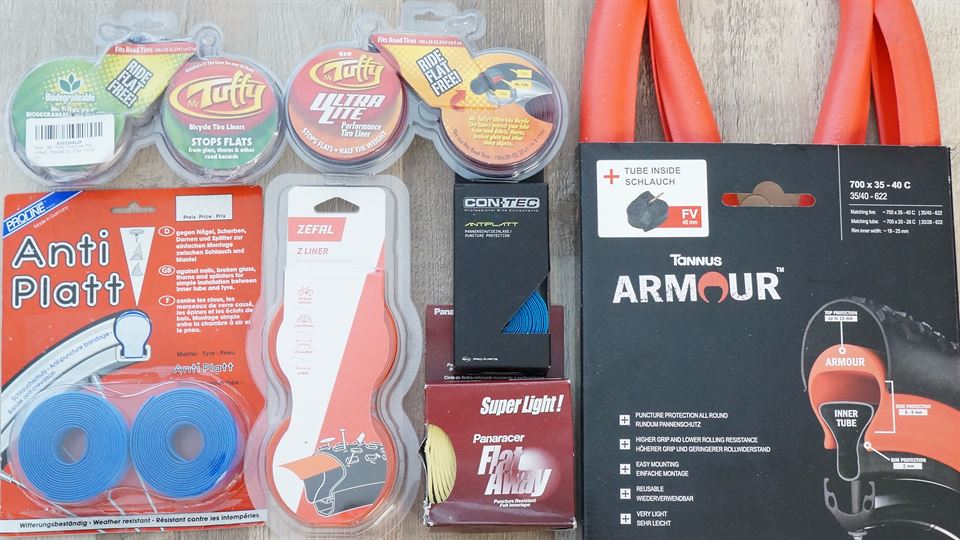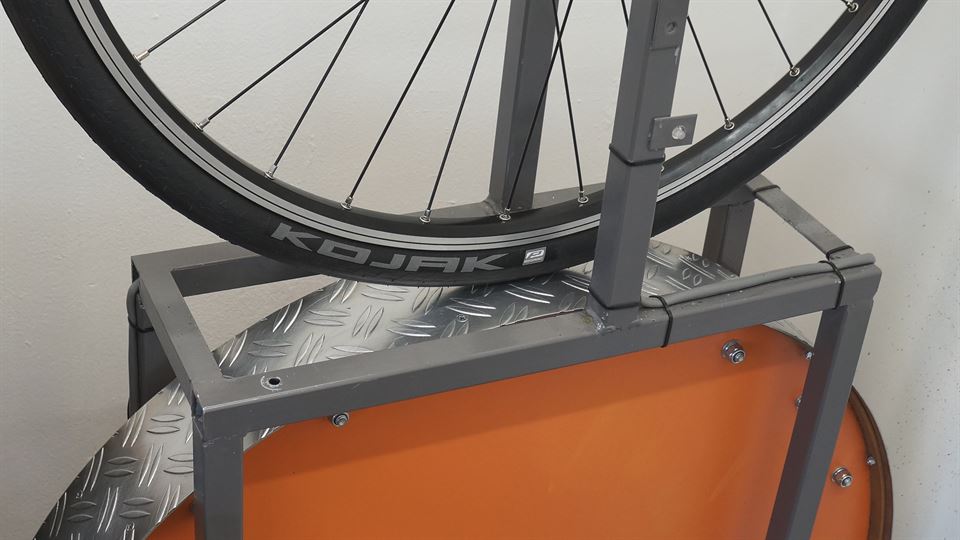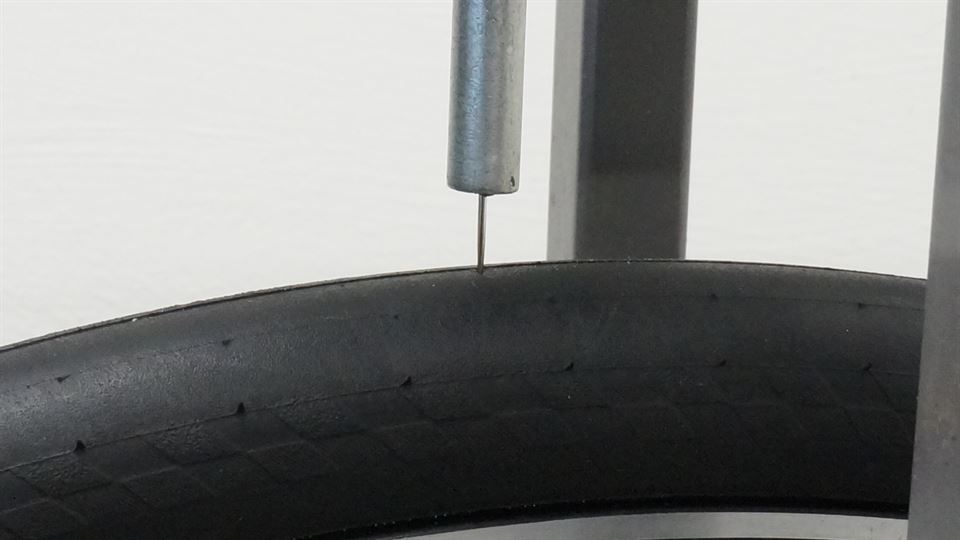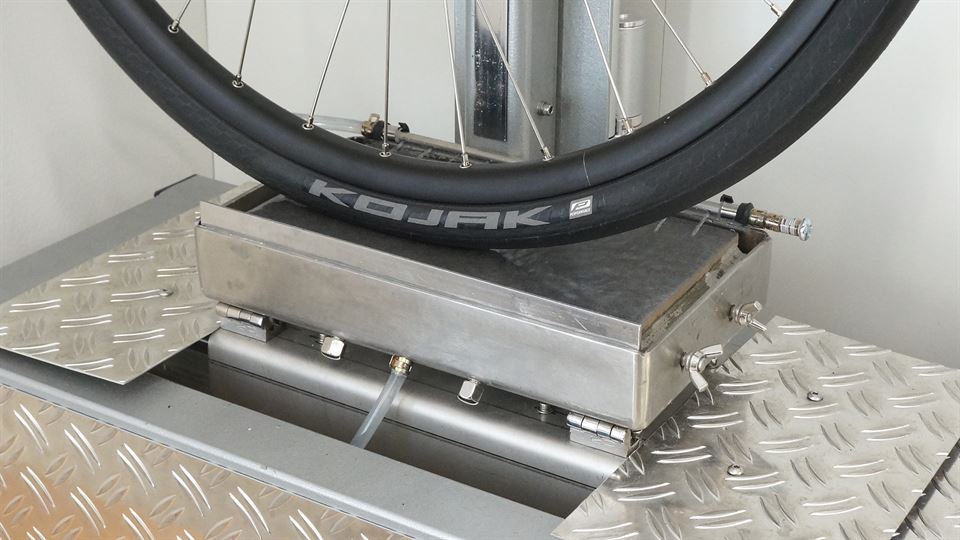Puncture Resistant Tire Liners Test: Puncture Resistance, Rolling Resistance, and Grip Tests.
Contents
- Introduction
- Test Set up and Conditions
- Weight, Width, Thickness Measurements
- Rolling Resistance Test Results
- Puncture Resistance Test Results
- Wet Grip Test Results
- Conclusion

Puncture-resistant tire liners are an interesting option to boost the puncture resistance of your tires. Over the years, many manufacturers have started offering these tire liners, but without a good comparison with real tests, it's impossible to know which liner is best.
We've done tests with a selection of puncture-resistant tire liners that we feel are the most popular and have the best availability. We've taken all the weight, width, and thickness measurements and tested their rolling resistance, puncture resistance, and their influence on tire grip.
You can find a good overview in the conclusion of this article, where we combined all test results in charts. The conclusion also offers an additional puncture resistance per watt of rolling resistance metric, which we feel will be the ultimate answer to which tire liner is best.
We again want to thank our Pro Members for their support and voting for this article. Without the support of our members, this test, and many other tests, wouldn't have been possible.
Test Set up and Conditions
We tested a selection of 7 tire liners with a Schwalbe Kojak in the 35 mm size. We decided on using the Schwalbe Kojak for the tire liner tests as it falls right in between road bike tires and beefier touring bike tires and should give a good indication of how the tire liners will perform.
We performed the obvious rolling and puncture resistance tests but also included the wet grip tests to get a complete picture of how the tire liners will affect the tire's performance.
We compared the tire liners to the performance of the bare Schwalbe Kojak. Also, We included the Schwalbe Marathon Almotion TLE and Marathon E-Plus to compare the tire liners to tires that come with higher protection from the factory. You can find the Marathon Almotion and Marathon E-Plus data in the charts where the total tire + tire liner data is compared.
The Tannus Armour puncture liner is a bit of an outlier in this lineup as it's much bigger and offers much more protection. The Tannus Armour also comes with a specific inner tube smaller than you typically use for a 35 mm wide tire. We used the supplied Tannus inner tube for the Tannus Armour tests.
The other tire liners we tested are the more traditional strips that only protect the central tread of the tires. We tried getting tire liners with a width as close to 30 mm as possible, but due to availability issues, the liners range between 26 and 31 mm in width.
- Contec Anti-Platt
- Mr Tuffy
- Mr Tuffy Ultralite
- Panaracer FlatAway
- Proline Anti-Platt
- Tannus Armour
- Zefal Z-Liner
Test Conditions
- Total wheel load of 42.5 kg / 94 lbs
- 700 x 18 mm wheel
- Diamond plate drum surface
- 77 cm drum diameter
- Air pressure of 60 psi for all tests
Tire Liners Weight, Width, and Thickness Measurements
| Weight, Width, and Thickness Measurements | |||
|---|---|---|---|
| Tire Liner | Weight | Width | Thickness |
| Contec Anti-Platt | 70 grams | 31 mm | 1.0 mm |
| Mr Tuffy | 63 grams | 26 mm | 1.1 mm |
| Mr Tuffy Ultralite | 61 grams | 26 mm | 1.1 mm |
| Panaracer FlatAway | 29 grams | 30 mm | 0.7 mm |
| ProLine Anti-Platt | 110 grams | 31 mm | 1.3 mm |
| Tannus Armour | 221 grams | 86 mm | 12.0 mm |
| Zefal Z-Liner | 62 grams | 27 mm | 0.9 mm |
Let's start with the weight measurements, where we see the Panaracer FlatAway being the lightest tire liner with a weight of just 29 grams. Most other tire liners come in at around 60-70 grams, while the ProLine Anti-Platt comes in a bit heavier at 110 grams. The obvious exception here is the huge Tannus Armour full tire liner that comes in at 221 grams, which isn't even all that bad considering the size of this liner.
As mentioned before, we tried to shoot for liners as close to 30 mm as possible, but due to availability issues, the regular tire liners on test here have a width of between 26 and 31 mm. The width of the liners will affect the other test results as the wider liners should provide better puncture resistance along the edge of the tread but come at the cost of a higher weight and higher rolling resistance.
The thickness of the regular liners seems to be quite similar as we measured the thinnest liner at 0.7 mm and the thickest at 1.3 mm. The Tannus Armour comes in at a whopping 12.0 mm and, together with the thickness of the Schwalbe Kojak itself, results in a total distance from inner tube to the outside of the tread of 15.9 mm.
If you care about puncture resistance, the thickness of the tire liners will be one of the most critical factors in preventing punctures, as objects that enter the tire but aren't long enough to reach the inner tube will never cause a puncture.
Test Results
Rolling Resistance Test Results

| Rolling Resistance Schwalbe Kojak 35-622 | ||
|---|---|---|
| Tire Liner | Rolling Resistance | Increase |
| Watts | Watts | |
| Schwalbe Kojak No Liner | 25.0 | |
| Contec Anti-Platt | 33.6 | + 8.6 |
| Mr Tuffy | 26.9 | + 1.9 |
| Mr Tuffy Ultralite | 26.7 | + 1.7 |
| Panaracer FlatAway | 39.4 | + 14.4 |
| ProLine Anti-Platt | 30.1 | + 5.1 |
| Tannus Armour | 38.6 | + 13.6 |
| Zefal Z-Liner | 27.6 | + 2.6 |
Everybody wants their tires to be puncture-resistant, but nobody wants them to roll slower. Puncture and rolling resistance are at odds with each other as increasing puncture resistance nearly always results in increasing rolling resistance.
In the rolling resistance tests, both Mr Tuffy tire liners seem to be miles ahead of the competition as they come with a rolling resistance penalty of fewer than 2 watts. The Zefal Z-Liner also performs strongly here as it comes in slightly behind both Mr Tuffy liners with a rolling resistance penalty of 2.6 watts.
The big shocker here is the Panaracer FlatAway which adds a massive amount of rolling resistance to your tires and performs even worse than the full protection Tannus Armour tire liner. The result of the FlatAway is even more surprising given it's the lightest tire liner on test here, which shows that low weight is no guarantee for low rolling resistance.
To dive into the rolling resistance performance of the FlatAway a bit more, we suspect the high rolling resistance is the result of movement between the inner tube, liner, and tire. The FlatAway is made of a different material than the other liners. It is a very slippery material that will result in the inner tube and tire liner rubbing against each other. The rubbing creates heat which translates into lost energy and higher rolling resistance.
The ideal inner tire liner will come coated in a grippy substance that prevents the rubbing between the inner tube, liner, and tire.
Puncture Resistance Test Results

| Puncture Resistance Schwalbe Kojak 35-622 | ||
|---|---|---|
| Tire Liner | Total Puncture Score | Increase |
| Tread / Sidewall | Tread / Sidewall | |
| Points | Points | |
| Schwalbe Kojak No Liner | 73 / 9 | |
| Contec Anti-Platt | 102 / 9 | + 29 / + 0 |
| Mr Tuffy | 136 / 9 | + 63 / + 0 |
| Mr Tuffy Ultralite | 125 / 9 | + 52 / + 0 |
| Panaracer FlatAway | 126 / 9 | + 53 / + 0 |
| ProLine Anti-Platt | 99 / 9 | + 26 / +0 |
| Tannus Armour | 245 / 16 | + 172 / + 7 |
| Zefal Z-Liner | 90 / 9 | + 17 / + 0 |
Stopping punctures is the only reason why you'd want to bear with the obvious drawbacks of puncture-resistant tire liners. If all you're looking for is maximum puncture resistance, stop here and get the Tannus Armour full tire liner, as it will prevent virtually all punctures.
If you're looking for a more performant tire liner, the Mr Tuffy tire liners again show a strong performance here while only adding a small amount of rolling resistance. The Zefal Z-Liner, which also performed quite strongly in the rolling resistance tests, offers abysmal performance in the puncture resistance tests and comes in last.
The Panaracer FlatAway does show good performance here, given its low weight. Still, as it's the worst performing liner regarding rolling resistance, it's already at a considerable disadvantage. The other liners do not stand out and only add a mediocre amount of puncture resistance and are a long way off the Mr Tuffy liners when we put everything together.
Wet Grip Test Results

| Wet Grip Schwalbe Kojak 35-622 | ||
|---|---|---|
| Tire Liner | Wet Grip Center | Increase |
| Points | Points | |
| Schwalbe Kojak No Liner | 72 | |
| Contec Anti-Platt | 65 | - 7 |
| Mr Tuffy | 67 | - 5 |
| Mr Tuffy Ultralite | 67 | - 5 |
| Panaracer FlatAway | 72 | - 0 |
| ProLine Anti-Platt | 69 | - 5 |
| Tannus Armour | 66 | -6 |
| Zefal Z-Liner | 64 | - 8 |
A grip test might not be an obvious test to add to a tire liner comparison, but since introducing our grip test, we've learned that casing flexibility is an important factor in the grip of a bicycle tire. As the puncture liners are quite stiff, they will reduce the tire's flexibility, resulting in less grip.
Our wet grip test results confirm our suspicions as nearly all tire liners reduce the Schwalbe Kojak's grip by 5 to 8 points. The Zefal Z-Liner is again the worst performing tire liner, while the Mr Tuffy liners show average performance.
The notable exception is the Panaracer FlatAway, which shows no grip reduction. As we've explained in the rolling resistance tests, the FlatAway is made of a much softer, slippier, and more flexible material than all other liners. The grip tests show that the flexibility of the Kojak's casing doesn't suffer from the FlatAway liner.
Conclusion
We feel the ultimate metric to compare the tire liners is calculating the additional puncture resistance per watt of additional rolling resistance. As you can see in the chart above, both Mr Tuffy tire liners outclass all the other tire liners in this metric.
Given that the Mr Tuffy tire liners also have one of the smallest reductions in grip, and their weight is very reasonable, we recommend just getting the Mr Tuffy liners. There doesn't seem to be a huge difference between the regular Mr Tuffy and the Ultralite, and they appear to be nearly the same product to us.
If you require the absolute maximum puncture resistance that can be achieved without moving to airless tires. In that case, we also recommend the Tannus Armour tire liners as they make punctures virtually impossible.
All the other products seem to have some huge drawbacks, and we simply can't recommend any of them.
